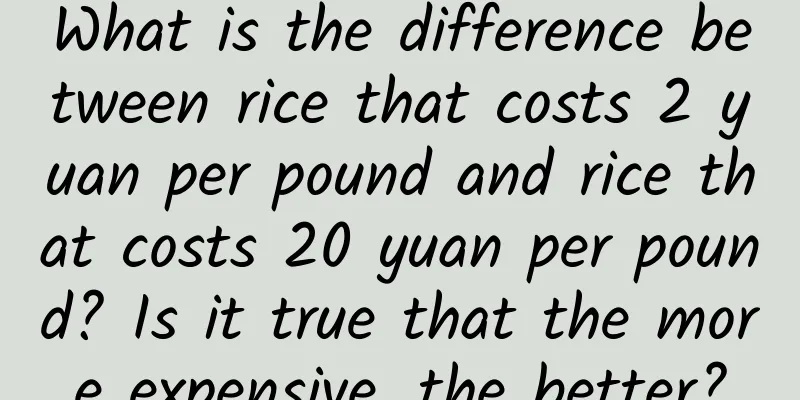What is the difference between rice that costs 2 yuan per pound and rice that costs 20 yuan per pound? Is it true that the more expensive, the better?

|
Rice has a supreme position in my country's food culture. The Chinese love rice so much that it can be said that "the love is stronger than gold"! Whether it is a hard dish like braised pork, or a light dish like stir-fried vegetables, tomatoes and eggs, it must be paired with a bowl of fragrant rice, that is perfect. Good rice comes from good rice. There are many kinds of rice on the market, and the prices vary greatly. Some rice costs two or three yuan per pound, while others cost twenty or thirty yuan per pound or even more. So, what is the difference between rice that costs more than ten times or even dozens of times more? Is the difference really that big? Which one is more worth buying? Copyright images in the gallery. Reprinting and using them may lead to copyright disputes. High and low price rice There are usually three differences 1 Rarity As the saying goes, things are valuable when they are scarce. The same is true for rice. For example, Wuchang rice, which is well-known in the rice industry, has a very limited annual output due to its unique growing environment and planting techniques, especially the high-quality variety Daohuaxiang No. 2, which has an even lower output, so the price is naturally high. As for other common varieties of rice, their prices are naturally relatively low due to their large yield and widespread cultivation. 2 Complex process or procedure Complex technology or process is another factor affecting the high price. These rices use special technology and processes in the planting and processing process, which makes them have higher quality or convenience, such as organic rice and wash-free rice. However, these special processes also increase the cost and price of rice. In contrast, ordinary rice does not have these additional functions and characteristics, so the price is naturally more affordable. For example, organic rice is prohibited from using chemical pesticides and fertilizers, and more manpower is required to maintain the ecological balance of the rice fields and resist pests and diseases. In addition, strict quality control further increases the workload. Without the use of chemical ingredients such as pesticides, the yield of organic rice is relatively low, resulting in an increase in the overall production cost. In addition, wash-free rice can be eaten directly without washing. This is because during the rice processing, a process of removing rice bran powder is added to ensure that there is very little bran powder remaining on the surface, thereby simplifying the processing steps before cooking. However, this increases the production cost, resulting in a higher price than ordinary rice. 3 Concept Meter Now let's talk about various concept rices. In recent years, many rices with special functions have appeared on the market, such as selenium-enriched rice, pearl rice, germ rice, etc. Pearl rice is essentially japonica rice, but it is a type of rice that is flat and round and resembles pearls. From the perspective of nutritional value and production technology, it is not much different from ordinary rice. So far, there is no corresponding national standard. However, due to the promotion of the "concept", the price is higher than that of ordinary rice. There are also some, such as selenium-enriched rice and germ rice, which increase the complexity of the processing technology or require a special planting environment in order to supplement or retain more nutrients. In addition to the concept, there are also additional production costs, so the price is higher. Copyright images in the gallery. Reprinting and using them may lead to copyright disputes. What to really look for when buying rice These are the 3 points 1 See type According to the recommended national standard for rice, rice can be divided into three categories according to the type of rice grains: indica rice, japonica rice and glutinous rice. What are the differences between these three types of rice? One is the shape, the other is the stickiness. Because of differences in stickiness and taste, these three types of rice have different uses in cooking. In addition to steaming rice, indica rice is often used for making fried rice, such as Yangzhou fried rice and clay pot rice; japonica rice is more suitable for steaming rice, making porridge, and making sushi, etc. Glutinous rice is sticky and suitable for making rice dumplings, pineapple rice, eight-treasure rice, etc. When cooking, different types of rice can be selected for different purposes. 2 Look at the standard There are many standards for rice. Some places will implement the national standards for geographical indication products. For example, Wuchang rice in Northeast China implements GB/T 19266 "Wuchang Rice, Geographical Indication Product". Because there are many places producing rice in China, and most of them are not in the areas required by geographical indication products, most rice implements the standard of GB/T 1354 "Rice". If you are looking for landmark rice, you can't just look at the name on the package. For example, if it says Wuchang rice, but it uses the national standard for ordinary rice, it is not necessarily "authentic" Wuchang rice. If you want to buy landmark rice, look for these standards. If the rice you buy complies with GB/T 1354 "Rice", pay attention to the name and grade of the rice when purchasing. 3 Look at the name and level According to the quality, rice can be divided into two categories: rice and high-quality rice. As the name implies, high-quality rice is better than rice. Taking the amount of broken rice as an example, the minimum requirement for rice quality is no more than 30%, while the minimum requirement for high-quality rice is no more than 15%. When buying, look for products with "high quality" in the name. Don't worry, the seller will do his best to let you know its goodness. Picture taken from the Internet In addition to "high quality", we also need to look at the grade. Even high-quality rice is divided into grade one, grade two, and grade three. How are these grades divided? They are mainly based on the impurity rate, processing accuracy, taste, and other dimensions. In general, grade one is the best, followed by grade two and grade three. Source: GB/T 1354-2018 Rice Some people may worry that the higher the grade, the higher the degree of processing, will it affect the nutrition? The answer is yes, but don't worry too much about it, because no matter what grade, the nutrition of refined rice is not the same as that of brown rice, they are both starch-based food for filling the stomach. So if you want to buy something with good taste and quality, the first choice is the premium grade one. Buy the right rice You also have to eat right 1 If you choose and eat rice like this, it can also help control blood sugar Rice is a traditional staple food on the table and is also the main factor that raises blood sugar. If you need to lose weight or control blood sugar, you must first understand a concept, which is the GI of food, that is, the glycemic index. The higher the GI, the faster the blood sugar rises and the greater the impact on blood sugar. To lower the GI of staple food, remember the following points: 1) Use more brown rice instead of refined rice The higher the degree of processing, the easier it is to digest, and the faster the blood sugar rises. Brown rice has a much lower GI than polished rice. When steaming rice, you can gradually replace polished rice with brown rice. Of course, the same principle applies to adding other coarse grains to rice. 2) Indica rice instead of japonica rice If you don't like the taste of brown rice and prefer to eat white rice, then it is recommended that you choose indica rice to steam rice. Because indica rice is not as sticky as japonica rice, it raises blood sugar more slowly than japonica rice. 3) Don’t make the steamed rice too sticky Even for the same ingredients, different cooking times and pressures will have different effects on blood sugar. In general, the stickier the rice, the easier it is to digest, and the greater the impact on blood sugar. Try to make it a little chewy to slow down digestion and be more friendly to blood sugar. 2 Master the method, staple food can also be nutritious As a finely processed grain, rice is mainly starch-based, with very few vitamins and minerals. In order to balance the nutrition of rice, there are a few suggestions when cooking: 1) Don’t wash too much Although refined rice has less vitamins, it is better than nothing. Therefore, the more times you wash the rice , the better. Excessive washing will increase the loss of water-soluble vitamins and some minerals. It is recommended to control the number of times to less than 3. Use cold water when washing and do not rub it too much. 2) Germ rice is better than ordinary rice Germ rice is made from ordinary rice, but retains the essence of rice, the germ. This way, you can enjoy the taste of rice while also getting nutrients such as vitamin E and essential fatty acids. However, you must be careful to store it after opening it to prevent the germ from becoming rancid and spoiled. 3) Add 1/3 to 1/2 of coarse grains and steam together Japonica rice is delicious but low in nutrition. Steaming it with coarse grains rich in dietary fiber and vitamins can achieve a balance in nutrition and taste. For example, brown rice, oats, and red beans. Especially beans can complement the amino acids of rice and improve the utilization rate of protein. References [1] Harbin Wuchang Municipal People’s Government. Government Work Report 2022-2023. http://www.hljwch.gov.cn/art/2023/1/12/art_28584_1351002.html [2] Asian rice prices approach 15-year high, domestic rice market remains stable. https://baijiahao.baidu.com/s?id=1784608192030925863&wfr=spider&for=pc [3] Yang Yuexin. Standard Edition of Chinese Food Composition Table (6th Edition/Volume 1). Beijing: Peking University Medical Press, 2019. [4] Wang Shuying, Fan Zhihong, Liu Bo. Digestibility of carbohydrates in different rice varieties[J]. Journal of China Agricultural University, 2012. DOI:CNKI:SUN:NYDX.0.2012-04-023. [5] GB/T 1354-2018 Rice [6] GB/T 19266-2008 Geographical Indication Product Wuchang Rice [7] GB/T 18824-2008 Geographical Indication Product Panjin Rice [8] GB/T 20040-2005 Geographical Indication Product Fangzheng Rice [9] GB/T 22438-2008 Geographical Indication Product Yuanyang Rice Planning and production Author: Li Chun, registered nutritionist Review | Ruan Guangfeng, Deputy Director of Kexin Food and Health Information Exchange Center Planning丨Zhong Yanping Editor: Zhong Yanping Proofread by Xu Lailinlin |
<<: @This "famous mouth" in the bird world: Why do you like to "eat your colleagues"?
Recommend
Douyin Operation: An experience of cold-starting and maintaining Douyin accounts!
In mid-2017, we entered the Douyin platform to te...
A female national security police officer captured a spy who had been lurking for 10 years! Details revealed for the first time
Hear in silence, see in formlessness The turbulen...
How to make sign-in a powerful tool to increase user activity!
This article will explain which apps are suitable...
7 marketing strategies to increase user repurchase!
We who do marketing often encounter a classic pro...
7-day XMindZEN vertical screen course
This course is suitable for those who have no bas...
In the tech world full of swagger and extravagance, what is real innovation?
[[154439]] In recent years, the competition in th...
New energy vehicles gradually enter the transition period, production qualification review may be relaxed
Recently, the National Development and Reform Com...
How does it feel to watch the big screen at the station on your mobile phone? Experience the new version of 12306
We no longer need to go to the train station to c...
Super "charming" elementary particles, triggering a missing mystery?
Neutrinos may be the most fascinating elementary ...
The "Second Uncle" in the scientific community: He turned a disaster into a blessing twice and eventually became a great scientist
A video describing the past half of the life of t...
How to promote online for free (low cost) (Part 1)
Recently, many people have asked me a question, h...
Community operation SOP strategy!
SOP generally refers to standard operating proced...
We were chatting happily, why did we start arguing?
Produced by: Science Popularization China Produce...
Losing money to gain publicity? The business logic behind LeTV's motherboard upgrade for 570,000 users
"For the past three years, LeTV has always h...
How many years can a mobile phone last? Three main factors determine the lifespan of a mobile phone
[[429168]] Computers have a history of developmen...









